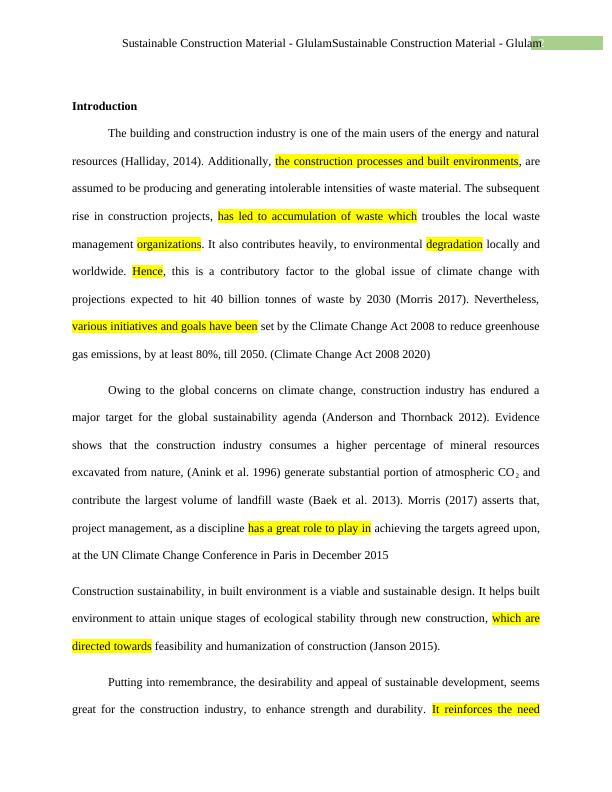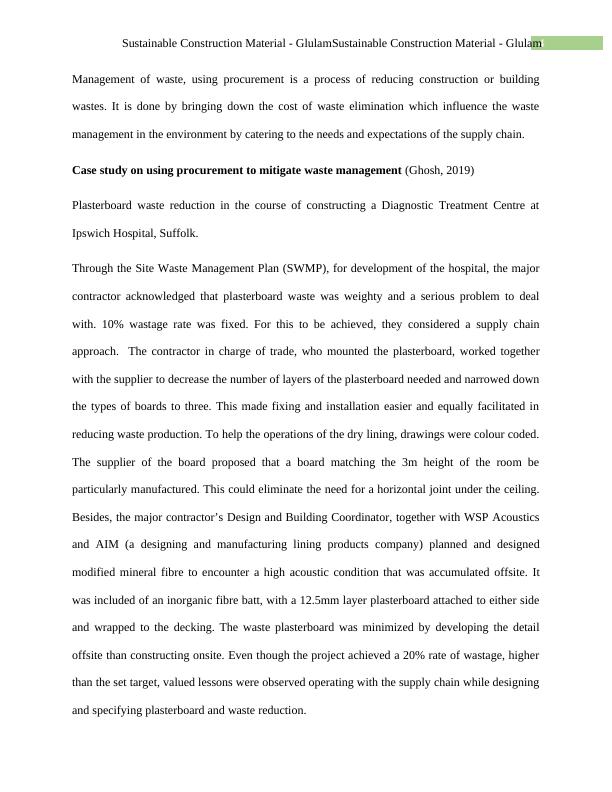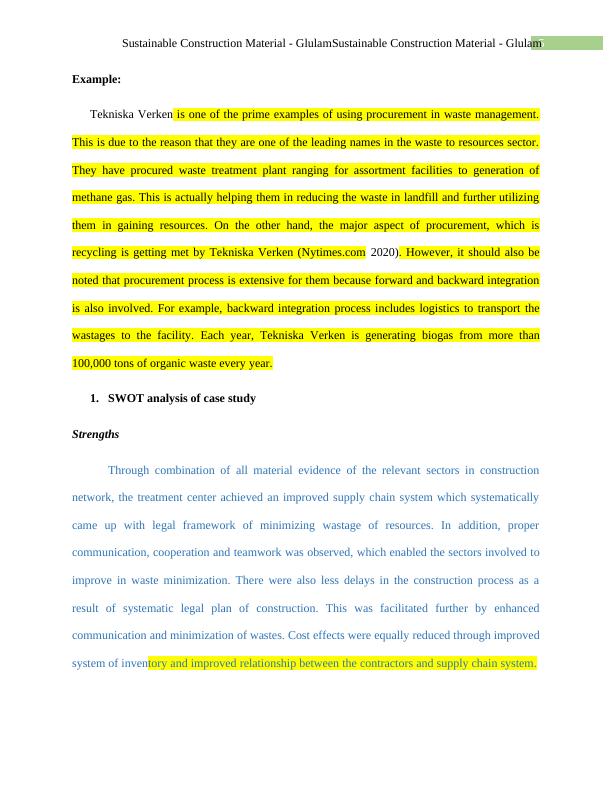Sustainable Construction Material - Glulam
A table of contents for a report on waste management in the construction industry, including case studies and a SWOT analysis.
24 Pages6023 Words20 Views
Added on 2022-08-31
Sustainable Construction Material - Glulam
A table of contents for a report on waste management in the construction industry, including case studies and a SWOT analysis.
Added on 2022-08-31
ShareRelated Documents
1IntroductionIntroduction
Sustainable Construction
Name of the Student:
Name of University:
Author Note
Sustainable Construction
Name of the Student:
Name of University:
Author Note

2Sustainable Construction Material - GlulamSustainable Construction Material - Glulam
Introduction
The building and construction industry is one of the main users of the energy and natural
resources (Halliday, 2014). Additionally, the construction processes and built environments, are
assumed to be producing and generating intolerable intensities of waste material. The subsequent
rise in construction projects, has led to accumulation of waste which troubles the local waste
management organizations. It also contributes heavily, to environmental degradation locally and
worldwide. Hence, this is a contributory factor to the global issue of climate change with
projections expected to hit 40 billion tonnes of waste by 2030 (Morris 2017). Nevertheless,
various initiatives and goals have been set by the Climate Change Act 2008 to reduce greenhouse
gas emissions, by at least 80%, till 2050. (Climate Change Act 2008 2020)
Owing to the global concerns on climate change, construction industry has endured a
major target for the global sustainability agenda (Anderson and Thornback 2012). Evidence
shows that the construction industry consumes a higher percentage of mineral resources
excavated from nature, (Anink et al. 1996) generate substantial portion of atmospheric CO2 and
contribute the largest volume of landfill waste (Baek et al. 2013). Morris (2017) asserts that,
project management, as a discipline has a great role to play in achieving the targets agreed upon,
at the UN Climate Change Conference in Paris in December 2015
Construction sustainability, in built environment is a viable and sustainable design. It helps built
environment to attain unique stages of ecological stability through new construction, which are
directed towards feasibility and humanization of construction (Janson 2015).
Putting into remembrance, the desirability and appeal of sustainable development, seems
great for the construction industry, to enhance strength and durability. It reinforces the need
Introduction
The building and construction industry is one of the main users of the energy and natural
resources (Halliday, 2014). Additionally, the construction processes and built environments, are
assumed to be producing and generating intolerable intensities of waste material. The subsequent
rise in construction projects, has led to accumulation of waste which troubles the local waste
management organizations. It also contributes heavily, to environmental degradation locally and
worldwide. Hence, this is a contributory factor to the global issue of climate change with
projections expected to hit 40 billion tonnes of waste by 2030 (Morris 2017). Nevertheless,
various initiatives and goals have been set by the Climate Change Act 2008 to reduce greenhouse
gas emissions, by at least 80%, till 2050. (Climate Change Act 2008 2020)
Owing to the global concerns on climate change, construction industry has endured a
major target for the global sustainability agenda (Anderson and Thornback 2012). Evidence
shows that the construction industry consumes a higher percentage of mineral resources
excavated from nature, (Anink et al. 1996) generate substantial portion of atmospheric CO2 and
contribute the largest volume of landfill waste (Baek et al. 2013). Morris (2017) asserts that,
project management, as a discipline has a great role to play in achieving the targets agreed upon,
at the UN Climate Change Conference in Paris in December 2015
Construction sustainability, in built environment is a viable and sustainable design. It helps built
environment to attain unique stages of ecological stability through new construction, which are
directed towards feasibility and humanization of construction (Janson 2015).
Putting into remembrance, the desirability and appeal of sustainable development, seems
great for the construction industry, to enhance strength and durability. It reinforces the need

3Sustainable Construction Material - GlulamSustainable Construction Material - Glulam
forrecycling and reusing of materials while manufacturing new materials, which is a sign of
progress for the industry and to achieve sustainability.
Recovery and regaining material wastes in construction industry aids in protecting the
environment or ecosystem by decreasing the amount of landfilled waste. This is achieved by
protecting the environment and reducing the amount of wastes which fill the land to a great
degree. The process is significant is it makes usage of resources, construction of building and
management of destruction waste more cohesive (Khatib 2017).
Development and growth of the building industry, worldwide,e has advanced to a visible
rise in the generation of the demolition and construction waste, thus creating an inspiration to
recognise extra effective means to achieve proper management of the wastes (Doyle 2012).
This paper explores construction practices which have been adopted by the construction industry
as a response to climate change and to achieve sustainability.
1. Management of waste using procurement to mitigate waste management
Waste management is the process of handling solid and liquid wastes by aiding answers or
solutions for re-usage and recycling of objects and substances (Chandra 2017). This is how
garbage can be reduced and re-used, in order to give rise to another valued resource.
Activities in all phases of conveyance project process and the determination of research have
been focussed on, for the project. It would include building and construction phases as well as
increasing possibilities for reducing waste, through the means of resource and materials
procurement process (Construction Specification Institute 2012). The procurement process
exploits exploratory and varied approach method sequentially as its framework.
forrecycling and reusing of materials while manufacturing new materials, which is a sign of
progress for the industry and to achieve sustainability.
Recovery and regaining material wastes in construction industry aids in protecting the
environment or ecosystem by decreasing the amount of landfilled waste. This is achieved by
protecting the environment and reducing the amount of wastes which fill the land to a great
degree. The process is significant is it makes usage of resources, construction of building and
management of destruction waste more cohesive (Khatib 2017).
Development and growth of the building industry, worldwide,e has advanced to a visible
rise in the generation of the demolition and construction waste, thus creating an inspiration to
recognise extra effective means to achieve proper management of the wastes (Doyle 2012).
This paper explores construction practices which have been adopted by the construction industry
as a response to climate change and to achieve sustainability.
1. Management of waste using procurement to mitigate waste management
Waste management is the process of handling solid and liquid wastes by aiding answers or
solutions for re-usage and recycling of objects and substances (Chandra 2017). This is how
garbage can be reduced and re-used, in order to give rise to another valued resource.
Activities in all phases of conveyance project process and the determination of research have
been focussed on, for the project. It would include building and construction phases as well as
increasing possibilities for reducing waste, through the means of resource and materials
procurement process (Construction Specification Institute 2012). The procurement process
exploits exploratory and varied approach method sequentially as its framework.

4Sustainable Construction Material - GlulamSustainable Construction Material - Glulam
Management of waste, using procurement is a process of reducing construction or building
wastes. It is done by bringing down the cost of waste elimination which influence the waste
management in the environment by catering to the needs and expectations of the supply chain.
Case study on using procurement to mitigate waste management (Ghosh, 2019)
Plasterboard waste reduction in the course of constructing a Diagnostic Treatment Centre at
Ipswich Hospital, Suffolk.
Through the Site Waste Management Plan (SWMP), for development of the hospital, the major
contractor acknowledged that plasterboard waste was weighty and a serious problem to deal
with. 10% wastage rate was fixed. For this to be achieved, they considered a supply chain
approach. The contractor in charge of trade, who mounted the plasterboard, worked together
with the supplier to decrease the number of layers of the plasterboard needed and narrowed down
the types of boards to three. This made fixing and installation easier and equally facilitated in
reducing waste production. To help the operations of the dry lining, drawings were colour coded.
The supplier of the board proposed that a board matching the 3m height of the room be
particularly manufactured. This could eliminate the need for a horizontal joint under the ceiling.
Besides, the major contractor’s Design and Building Coordinator, together with WSP Acoustics
and AIM (a designing and manufacturing lining products company) planned and designed
modified mineral fibre to encounter a high acoustic condition that was accumulated offsite. It
was included of an inorganic fibre batt, with a 12.5mm layer plasterboard attached to either side
and wrapped to the decking. The waste plasterboard was minimized by developing the detail
offsite than constructing onsite. Even though the project achieved a 20% rate of wastage, higher
than the set target, valued lessons were observed operating with the supply chain while designing
and specifying plasterboard and waste reduction.
Management of waste, using procurement is a process of reducing construction or building
wastes. It is done by bringing down the cost of waste elimination which influence the waste
management in the environment by catering to the needs and expectations of the supply chain.
Case study on using procurement to mitigate waste management (Ghosh, 2019)
Plasterboard waste reduction in the course of constructing a Diagnostic Treatment Centre at
Ipswich Hospital, Suffolk.
Through the Site Waste Management Plan (SWMP), for development of the hospital, the major
contractor acknowledged that plasterboard waste was weighty and a serious problem to deal
with. 10% wastage rate was fixed. For this to be achieved, they considered a supply chain
approach. The contractor in charge of trade, who mounted the plasterboard, worked together
with the supplier to decrease the number of layers of the plasterboard needed and narrowed down
the types of boards to three. This made fixing and installation easier and equally facilitated in
reducing waste production. To help the operations of the dry lining, drawings were colour coded.
The supplier of the board proposed that a board matching the 3m height of the room be
particularly manufactured. This could eliminate the need for a horizontal joint under the ceiling.
Besides, the major contractor’s Design and Building Coordinator, together with WSP Acoustics
and AIM (a designing and manufacturing lining products company) planned and designed
modified mineral fibre to encounter a high acoustic condition that was accumulated offsite. It
was included of an inorganic fibre batt, with a 12.5mm layer plasterboard attached to either side
and wrapped to the decking. The waste plasterboard was minimized by developing the detail
offsite than constructing onsite. Even though the project achieved a 20% rate of wastage, higher
than the set target, valued lessons were observed operating with the supply chain while designing
and specifying plasterboard and waste reduction.

5Sustainable Construction Material - GlulamSustainable Construction Material - Glulam
Example:
Tekniska Verken is one of the prime examples of using procurement in waste management.
This is due to the reason that they are one of the leading names in the waste to resources sector.
They have procured waste treatment plant ranging for assortment facilities to generation of
methane gas. This is actually helping them in reducing the waste in landfill and further utilizing
them in gaining resources. On the other hand, the major aspect of procurement, which is
recycling is getting met by Tekniska Verken (Nytimes.com 2020). However, it should also be
noted that procurement process is extensive for them because forward and backward integration
is also involved. For example, backward integration process includes logistics to transport the
wastages to the facility. Each year, Tekniska Verken is generating biogas from more than
100,000 tons of organic waste every year.
1. SWOT analysis of case study
Strengths
Through combination of all material evidence of the relevant sectors in construction
network, the treatment center achieved an improved supply chain system which systematically
came up with legal framework of minimizing wastage of resources. In addition, proper
communication, cooperation and teamwork was observed, which enabled the sectors involved to
improve in waste minimization. There were also less delays in the construction process as a
result of systematic legal plan of construction. This was facilitated further by enhanced
communication and minimization of wastes. Cost effects were equally reduced through improved
system of inventory and improved relationship between the contractors and supply chain system.
Example:
Tekniska Verken is one of the prime examples of using procurement in waste management.
This is due to the reason that they are one of the leading names in the waste to resources sector.
They have procured waste treatment plant ranging for assortment facilities to generation of
methane gas. This is actually helping them in reducing the waste in landfill and further utilizing
them in gaining resources. On the other hand, the major aspect of procurement, which is
recycling is getting met by Tekniska Verken (Nytimes.com 2020). However, it should also be
noted that procurement process is extensive for them because forward and backward integration
is also involved. For example, backward integration process includes logistics to transport the
wastages to the facility. Each year, Tekniska Verken is generating biogas from more than
100,000 tons of organic waste every year.
1. SWOT analysis of case study
Strengths
Through combination of all material evidence of the relevant sectors in construction
network, the treatment center achieved an improved supply chain system which systematically
came up with legal framework of minimizing wastage of resources. In addition, proper
communication, cooperation and teamwork was observed, which enabled the sectors involved to
improve in waste minimization. There were also less delays in the construction process as a
result of systematic legal plan of construction. This was facilitated further by enhanced
communication and minimization of wastes. Cost effects were equally reduced through improved
system of inventory and improved relationship between the contractors and supply chain system.

6Sustainable Construction Material - GlulamSustainable Construction Material - Glulam
One of the major strengths of procurement process in waste management is cost
effectiveness. This is due to the reason that generation of waste does not involve any added costs.
This is reducing the cost of raw materials (Jiménez-Rivero, Guzmán-Báez & García-Navarro
2017). It should also be noted that procurement process will also be effective in optimal
utilization of resources. Procurement also promotes innovation because innovating new
technologies will help in further development of waste management.
Weaknesses
Implementation of wastes management through supply chain approach was poorly done.
There was no indication of financial and time investment. This indicates that there could be cases
of redundancy in service delivery and possibly neglecting deadlines and the set targets. In
addition, long-term waste management plan was not established by the SWMP.
The major weakness of the project is the poor implementation, which affected the entire
process. Ineffective planning can be characterized as the reason behind clumsiness and thus
lacking precision of working which will result in more wastes. The financial aspects of the
projects were not pre planned and structured, which is very crucial otherwise the risks factors
rise, leading to failures and budget constraints during a project. The ultimate goal of the project
was to lessen wastes, which was not achieved during the process.
Opportunities
One of the major strengths of procurement process in waste management is cost
effectiveness. This is due to the reason that generation of waste does not involve any added costs.
This is reducing the cost of raw materials (Jiménez-Rivero, Guzmán-Báez & García-Navarro
2017). It should also be noted that procurement process will also be effective in optimal
utilization of resources. Procurement also promotes innovation because innovating new
technologies will help in further development of waste management.
Weaknesses
Implementation of wastes management through supply chain approach was poorly done.
There was no indication of financial and time investment. This indicates that there could be cases
of redundancy in service delivery and possibly neglecting deadlines and the set targets. In
addition, long-term waste management plan was not established by the SWMP.
The major weakness of the project is the poor implementation, which affected the entire
process. Ineffective planning can be characterized as the reason behind clumsiness and thus
lacking precision of working which will result in more wastes. The financial aspects of the
projects were not pre planned and structured, which is very crucial otherwise the risks factors
rise, leading to failures and budget constraints during a project. The ultimate goal of the project
was to lessen wastes, which was not achieved during the process.
Opportunities

End of preview
Want to access all the pages? Upload your documents or become a member.
Related Documents
SUSTAINABLE CONSTRUCTION TOPIC 1: Management of waste using procurement to mitigate waste managementlg...
|20
|3967
|21
Applicability of Green Engineering Solution in International Constructionlg...
|18
|6815
|126
Sustainable Building Techniques and Materialslg...
|24
|5694
|55
Importance of Waste Management on Construction Siteslg...
|11
|714
|428
BNV 7036 Sustainable Construction Assignmentlg...
|12
|5086
|142
Sustainable Construction Assignment PDFlg...
|21
|4803
|40
